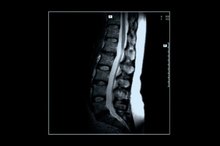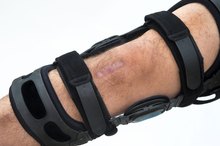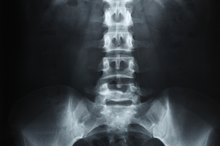What Are the Treatments for a Vertebral Hemangioma?
A tumor composed of dilated blood vessels that grows along the bones in the spinal cord is a condition called a vertebral or spinal hemangioma. People with this type of spinal tumor typically don't experience symptoms, especially when the hemangioma is small. If the tumor grows larger, patients can begin to experience debilitating symptoms, such as chronic back pain or paralysis. Patients who develop such symptoms should talk with a doctor regarding the treatment for a vertebral hemangioma.
Alleviation of Pain
Initially, a physician may recommend various types of pain management to help alleviate discomfort. This type of treatment for a vertebral hemangioma is the least invasive and can involve a combination of therapies, including acupuncture, pain medication or corticosteroid injections, according to Back.com. If these forms of treatment are ineffective, patients should talk with a doctor about more invasive forms of vertebral hemangioma treatment.
Radiation Therapy
Symptoms of Lumbar Hemangioma
Learn More
Radiation therapy can be used to treat a vertebral hemangioma, Cedars-Sinai Medical Center reports. During treatment, a radiologist applies external high-energy x-rays directly to the location of the vertebral hemangioma. The radiation x-rays destroy the cells in the spinal tumor, preventing the hemangioma from advancing. Radiation therapy can also cause the tumor to shrink in size, which can help alleviate back pain symptoms in treated patients. Patients should discuss the side effects and complications of radiation therapy with a medical professional before undergoing this type of treatment for a vertebral hemangioma.
- Radiation therapy can be used to treat a vertebral hemangioma, Cedars-Sinai Medical Center reports.
- The radiation x-rays destroy the cells in the spinal tumor, preventing the hemangioma from advancing.
Surgical Removal of Hemangioma
Surgical removal of the tumor is a potential treatment option for a vertebral hemangioma. The extent of spinal surgery, also called surgical resection, depends upon the size of the hemangioma, according to Indiana University-Purdue University Indianapolis. Large hemangiomas may require a surgeon to also remove portions of the affected vertebra during surgery. Removing the spinal tumor decreases the amount of pressure placed on the spinal cord, which diminishes or eliminates back pain or discomfort. Spinal surgery is a major procedure and can result in certain complications, such as spinal cord injury, blood clots or infection, the University of Maryland Medical Center reports. Patients should discuss the risks of this form of vertebral hemangioma treatment with a physician prior to surgery.
- Surgical removal of the tumor is a potential treatment option for a vertebral hemangioma.
- Spinal surgery is a major procedure and can result in certain complications, such as spinal cord injury, blood clots or infection, the University of Maryland Medical Center reports.
Embolization
Complications of Lumbar Laminectomy
Learn More
Another form of surgical treatment for a vertebral hemangioma is called embolization. During this procedure, a surgeon ties off the blood vessel that supplies blood to the hemangioma. Cutting off blood flow to the spinal tumor causes it to either decrease in size or stop advancing. Alternatively, a surgeon may perform this type of treatment prior to removing the hemangioma from the vertebra, according to BoneTumor.org.
- Another form of surgical treatment for a vertebral hemangioma is called embolization.
- During this procedure, a surgeon ties off the blood vessel that supplies blood to the hemangioma.
Related Articles
References
- Back.com: Tumors - Hemangioma
- BoneTumor.org: Hemangioma
- Cedars-Sinai Medical Center: Hemangioma
- Indiana University-Purdue University Indianapolis: Hemangioma of Bone
- Evans J, Sabih DE. Hemangioma, Cavernous Liver. NCBI StatPeals Publishing website.
- Bajenaru N, Balaban V, Săvulescu F, Campeanu I, Patrascu T. Hepatic hemangioma -review-.Journal of Medicine and Life. 2015; 8(Spec Issue): 4–11.
- Kamyab AA, Rezaei-kalantari K. Hepatic Hemangioma in a Cluster of Iranian Population. J Med Ultrasound. 2019;27(2):97-100. doi:10.4103/JMU.JMU_98_18
- Toro A, Mahfouz AE, Ardiri A, et al. What is changing in indications and treatment of hepatic hemangiomas. A review. Ann Hepatol. 2014;13(4):327-39. doi:10.1016/s1665-2681(19)30839-7
- Maruyama M, Isokawa O, Hoshiyama K, Hoshiyama A, Hoshiyama M, Hoshiyama Y. Diagnosis and Management of Giant Hepatic Hemangioma: The Usefulness of Contrast-Enhanced Ultrasonography. International Journal of Hepatology. 2013. doi: 10.1155/2013/802180
- Bajenaru N, Balaban V, Săvulescu F, Campeanu I, Patrascu T. Hepatic hemangioma -review-. Journal of Medicine and Life. 2015; 8(Spec Issue): 4–11.
Writer Bio
Rae Uddin has worked as a freelance writer and editor since 2004. She specializes in scientific journalism and medical and technical writing. Her work has appeared in various online publications. Uddin earned her Master of Science in integrated biomedical sciences with an emphasis in molecular and cellular biochemistry from the University of Kentucky College of Medicine.









